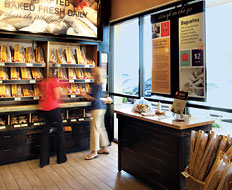Kelly’s Roast Beef
Headquarters: Saugus, Massachusetts
Founded: 1951
Number of units: 6
In its 60 years of operation, Kelly’s Roast Beef has become a Massachusetts good-eats legend. It began in 1951 with Frank McCarthy and Raymond Carey Jr. as a family owned hotdog stand that happened to sell roast beef at Revere Beach.
As much as for its medium-rare, tender knuckle–cut roast beef sandwich, Kelly’s is known for its volume. In 2010, it boasted sales of $26 million from its now six fast-casual units. It went through nearly 1 million pounds of french fries and 560,000 pounds of roast beef. Its second location in Saugus is one of the top users of Coca-Cola in the U.S., says Dean Murphy, Kelly’s director of operations. “They are impressed with our sales,” Murphy says.
For its 60th anniversary this year, Kelly’s is teaming up with Coca-Cola for weekly sweepstakes drawings in which the grand-prize winner will receive Boston Red Sox tickets.
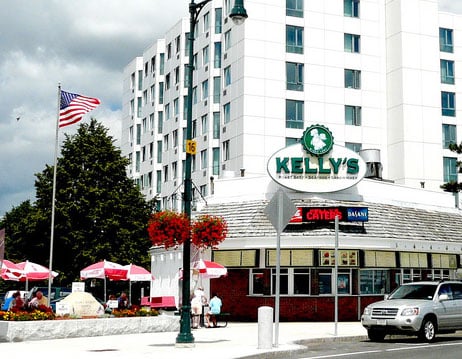 It comes as little surprise that the roast beef sandwich is Kelly’s biggest seller, priced at $5.95 and $6.95 a la carte. Some even insist that the operation was the country’s first to ever serve roast beef sandwiches. But the company’s fish and chips sell nearly as well, given the operation’s Boston-area locales. Therefore, the units always enjoy a sales spike during Lent, Murphy says. The menu is loaded with seafood options like fresh local clams, New England clam chowder, scallops, and its popular lobster roll, which contains 2 pounds of lobster for $16.95.
It comes as little surprise that the roast beef sandwich is Kelly’s biggest seller, priced at $5.95 and $6.95 a la carte. Some even insist that the operation was the country’s first to ever serve roast beef sandwiches. But the company’s fish and chips sell nearly as well, given the operation’s Boston-area locales. Therefore, the units always enjoy a sales spike during Lent, Murphy says. The menu is loaded with seafood options like fresh local clams, New England clam chowder, scallops, and its popular lobster roll, which contains 2 pounds of lobster for $16.95.
There are no LTOs, but that doesn’t mean the menu has been stagnant for all these years. “We realized that people eat other things. So we have added wraps, salads, and soups,” Murphy says, noting that these items appease the younger generation and the health-conscious.
There are no immediate plans to expand Kelly’s, now in its second generation of operation. “Location is everything for us. We are not actively pursuing new ones, but we are willing to look at what might become available. Our growth will be slow,” Murphy says.
Four of the units have drive thrus, and all of the food preparation is done at each individual location. The initial beach location operates from only 1,200 square feet, so when the Saugus location opened, the family included everything on its wish list, including a large seating area and plenty of storage space. It came in at 12,000 square feet. The other units range from 6,000 to 8,000 square feet. Some 400 employees help to keep the volume up.
Nick’s Pizza & Pub
Headquarters: Crystal Lake, Illinois
Founded: 1995
Number of units: 2
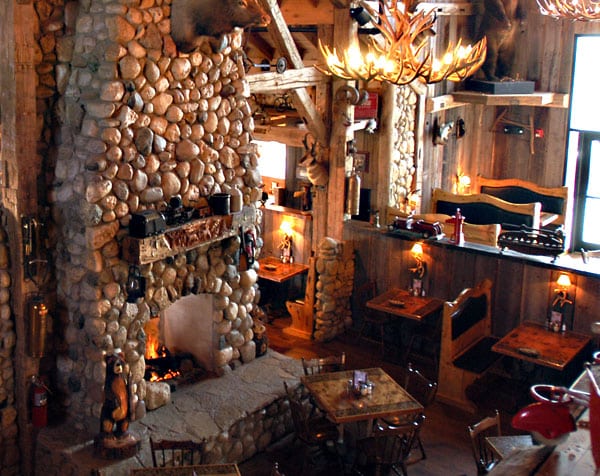 With two units in the Chicago area, Nick’s Pizza & Pub has made its imprint, not for Chicago-style pizza, but for its homemade, crispy, thin-crust pies. The dough, sauce, sausage, cheese, and Italian beef come from 40-year-old family recipes, says Nick Sarillo, president and founder.
With two units in the Chicago area, Nick’s Pizza & Pub has made its imprint, not for Chicago-style pizza, but for its homemade, crispy, thin-crust pies. The dough, sauce, sausage, cheese, and Italian beef come from 40-year-old family recipes, says Nick Sarillo, president and founder.
He opened the first 350-seat restaurant in Crystal Lake, Illinois, in 1995 because he wanted a place where parents could take their kids for a good time and not receive scornful glares. Himself a carpenter, Sarillo built the 9,000-square-foot building using barn wood and antiques for a casual décor.
But the bigger story is Sarillo’s management style, in which he treats the 100 team members in each restaurant like part owners who share the company mission to provide the community an unforgettable place to connect with family and friends.
Team members are invited to weekly “fiscal huddles,” where they review the profit-and-loss statement. They volunteer to “own” a line item on either ledger sheet for a month. They forecast a number for that item and then aim to meet their number. For example: “Rather than me say not to waste napkins, they hold each other accountable as to how many napkins they put on the table,” Sarillo says.
One 16-year-old recently forecasted lunch sales and then devised a plan to meet his forecast by putting together an individual pizza-and-drink lunch special and promoting it at his high school.
It all provides intrinsic rather than external motivation and has helped the company keep employee turnover at an astonishingly low 25 percent annual rate. He is writing a book, tentatively called Pizza on Purpose, about his management style. It’s scheduled to release in 2012 by Portfolio, a division of Penguin Group USA Inc.
The company’s marketing is built solely on giving to community fundraisers in which 15 percent of a day’s sales go to the selected cause. It could be to help a school band, hockey team, Boy Scouts, or, recently, it was to raise money for a local family’s medical need. The group to benefit from the donation often hands out fliers, calls the newspaper, or promotes through social media, so the restaurant itself never has to advertise.
For its 2010 efforts, the company received the National Restaurant Association Illinois state Restaurant Neighbor Award in the small business category.
With the company still bouncing back from the recession, Sarillo’s growth plans for Nick’s Pizza & Pub are tentative, but he says he would like to open three more in the Chicago area by the end of 2012. Each of the units does slightly more than $3 million in annual sales.
[pagebreak]
LYFE Kitchen
Headquarters: Chicago
Number of units: 1
Founded: 2011
Industry eyes are trained on the much-anticipated opening of the first LYFE Kitchen (Love Your Food Everyday) in Palo Alto, California, scheduled for the end of August.
It is a new concept that doesn’t fit neatly in quick-serve, fast-casual, or any other service model, says Mike Donahue, founding partner and chief communications officer. The company is calling it a “lifestyle restaurant” where guests will feel like they can hang out and enjoy a sense of community or order food to go.
The restaurant concept was developed by investment banker Stephen Sidwell and former McDonald’s executive Mike Roberts, who took their vision of guilt-free, wholesome, affordable food to the restaurant drawing board and built a menu development dream team made up of celebrity chef Art Smith (former personal chef to Oprah Winfrey) and Tal Ronnen, famed vegan and vegetarian chef.
Guests will be greeted at the door of the 3,700-square-foot restaurant and will have food choices created to be flavorful, nourishing, and familiar. They’ll include breakfast burritos, sweet corn chowder, wild mushroom flatbread, classic Niman Ranch burgers, and Art’s unfried chicken. All dishes will be 600 or fewer calories, and everything is made without the use of fryers or microwaves. Lunch prices will range from $6 to $8 with dinner entrées running $14–$18.
 Besides the food, the technology may be what steals the show. The company plans to use ground-breaking table technology with proprietary iPad-like devices allowing for menu ordering, and perhaps music, lessons, and games. “A lot of [technology] companies have come to us with great ideas, so we’ll see what else we could do to maximize the customer experience,” Donahue says.
Besides the food, the technology may be what steals the show. The company plans to use ground-breaking table technology with proprietary iPad-like devices allowing for menu ordering, and perhaps music, lessons, and games. “A lot of [technology] companies have come to us with great ideas, so we’ll see what else we could do to maximize the customer experience,” Donahue says.
In keeping with the times, the company will be mindful of its environmental impact and will source produce locally whenever possible.
It will also operate in the new age of no advertising in favor of grassroots social media and community engagement, giving a percentage of profits to charity and to support local organizations and groups.
The concept’s main charity is Common Threads, which Smith cofounded to teach children from low-income families how to cook in order to help eliminate childhood obesity.
The company plans to open, test, and tweak the first restaurant and let guests vote with their wallets for the first 60–90 days before opening any more doors, Donahue says. Although Donahue’s not talking, there have been reports that as many as 250 units could open within five years.
Naked Pizza
Headquarters: New Orleans
Founded: 2007
Franchised: 2009
Number of units: 20
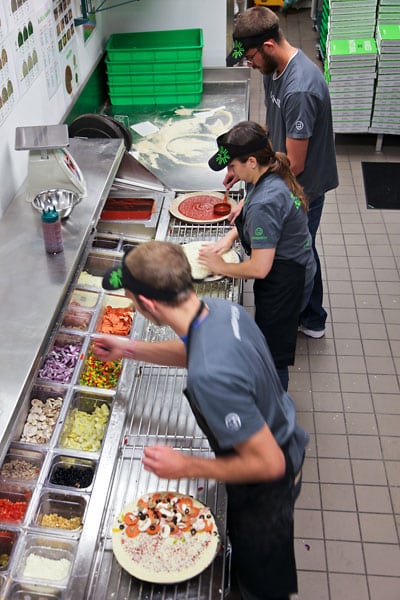 Naked Pizza thrives as a better-for-you pizza take-out and delivery operation. Its pizza crust is made of 10 grains and seeds with prebiotic fiber from agave plants and added probiotics for digestive health. The toppings are all natural, and gluten-free pizza is also available.
Naked Pizza thrives as a better-for-you pizza take-out and delivery operation. Its pizza crust is made of 10 grains and seeds with prebiotic fiber from agave plants and added probiotics for digestive health. The toppings are all natural, and gluten-free pizza is also available.
“We’ve taken the world’s most popular and unhealthy food and made it better,” says Robbie Vitrano, cofounder of the rapidly expanding New Orleans–based chain.
Entrepreneurs Jeff Leach and Randy Crochet opened Naked Pizza, a product of post-Katrina redevelopment, in 2007 under the name “World’s Healthiest Pizza.” The ill-chosen moniker was rebranded to Naked Pizza in 2008. “Aside from naked and pizza being the two most favorite words in the English language, we wanted a name that was fun, accessible, and that also captures our all-natural, common-sense ethos,” Vitrano says. He officially joined the company when Naked Pizza put together its franchise company in 2009, fueled by two billionaire investors—Robert Kraft and Mark Cuban.
It positions itself as a post-recession, post-mass-media company. A franchise store build out costs from $250,000 to $300,000 with minimal marketing costs, given its social media marketing strategy. The brand has more than 11,000 Twitter followers, an impressive number for a company of its size.
For the three months leading up to the opening of its first store in Dubai, Naked Pizza established itself as a credible Twitter voice during the Tunisian and Egyptian uprisings. “When the doors opened in Dubai, thousands of people showed up,” Vitrano says. Because of the company’s social media activity, customers were already familiar with Naked Pizza’s voice, which addresses issues of diet and health as well as entrepreneurship and sensible business practices.
It has grown to 20 units, with two open in Dubai, and has had some 6,000 franchise inquiries, with a few hundred units already in development.
By the end of 2011, the company expects to have as many as 70 units open, and likely 70 more in 2012. “If we decide to expand exponentially, we will be established [in large U.S. cities], and with that comes efficiencies in the ability to reach lots of people and continue to do what we do so well,” Vitrano says.
With a well-developed business model, fine-tuned operations procedures, and 26 available toppings, the company is positioning itself in the big leagues with the likes of Pizza Hut, Papa John’s, and Domino’s, with a healthy twist.
[pagebreak]
Wildflower Bread Company
Headquarters: Scottsdale, Arizona
Founded: 1996
Number of units: 11
What began in 1996 as a need for great bread in Scottsdale, Arizona, is now an 11-unit chain of trendy fast-casual restaurants.
Wildflower Bread Company founder Louis Basile came from a restaurateur family and spent part of his career at Boston-based Au Bon Pain, helping it to increase from 3 to 255 units during his 14-year tenure. He and his wife, Tracy, then moved to Arizona and dreamed up the new restaurant in the midst of a mass-market, chain-oriented food scene.
Great bread to Basile means hand-crafted loaves from dough starters carefully fed and nurtured. “We cultivate three: caraway rye, levain, and sourdough breads,” he says. Each loaf is a three-day process—started, mixed, shaped, and refrigerated in the central commissary before being transported to the restaurants for daily baking.
The company made artisan bread long before it became trendy. In addition, Basile likes to think of Wildflower as an early forerunner to the burgeoning fast-casual segment—something he is familiar with as a founding member and chairman of the Fast Casual Industry Council.
Particularly distinctive is Wildflower’s separate menu offerings for each daypart, all served from real china with silverware.
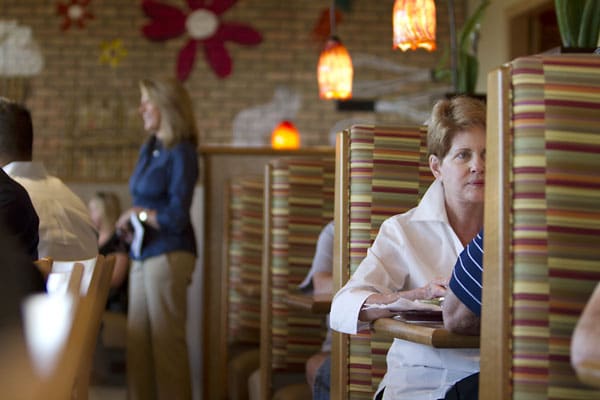 “We really believe we are serving white-tablecloth food at everyday, affordable prices,” Basile says. The gourmet menu items, like Wildflower’s signature Lemon Ricotta Pancakes served with blueberry compote, sweet creamy butter, and hot maple syrup for $6.39, support Basile’s argument. Many dishes have six or seven ingredients, as in the Roasted Sweet Potato Sandwich also featuring fresh mozzarella, fig confit, tomato, arugula, marinated fennel, and balsamic vinaigrette on herb focaccia for $7.49. After 3 p.m., guests can choose from the dinner menu with its eight pasta dishes. Limited-time-only menu items rotate in and out seasonally, all developed by a small in-house team that includes Basile.
“We really believe we are serving white-tablecloth food at everyday, affordable prices,” Basile says. The gourmet menu items, like Wildflower’s signature Lemon Ricotta Pancakes served with blueberry compote, sweet creamy butter, and hot maple syrup for $6.39, support Basile’s argument. Many dishes have six or seven ingredients, as in the Roasted Sweet Potato Sandwich also featuring fresh mozzarella, fig confit, tomato, arugula, marinated fennel, and balsamic vinaigrette on herb focaccia for $7.49. After 3 p.m., guests can choose from the dinner menu with its eight pasta dishes. Limited-time-only menu items rotate in and out seasonally, all developed by a small in-house team that includes Basile.
Each 3,000–5,100-square-foot unit is designed in keeping with the community, and charitable donations in lieu of traditional advertising are made to area causes as part of the Wildflower Cares program. Additionally, every night, leftover food is donated to shelters or churches.
“In our mind, we are out there to change lives, build communities, and feed people’s soul with passion. That’s our core driving force,” Basile says.
He plans to have 30–35 company-owned units open in the next five years, possibly into other states yet to be determined.

